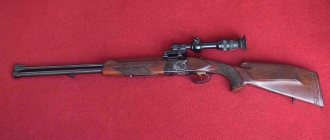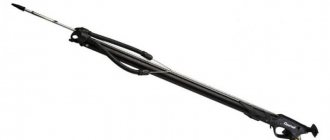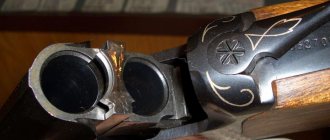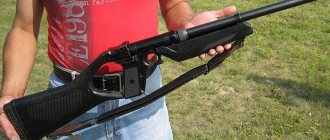The domestic TOZ 55 Zubr gun was developed at the Tula arms factory. The sample is represented by a high-level combined hunting weapon, with a pair of barrels that fold back at the moment of opening. TOZ 55, with its name “Bison,” tells us that its main purpose is hunting wild animals. Souvenir products are manufactured individually, in gift cases, equipped with high-quality accessories and other accessories.
Description
TOZ 55 Bison is a combined weapon, from which it is possible to fire bullets and shot from two barrels located vertically. By the way, the complete set of the Zubr gun includes five pairs of barrels:
- for bullets and shot – 9.27x12 caliber, length – 600 mm;
- smoothbore side flint, caliber 12 and 60 cm long;
- double-barreled fitting 9.27x74 mm for imported ammunition 9.3/74 mm, reaching a length of 60 cm;
- trench double-barreled sideflint, length – 75.0 cm;
- double-barreled side flint for a 67.5 cm round stand.
The combined barrels of the Bison rifle are rifled, equipped with folding shield-type rear sights and removable optics, the magnification of which varies from 1.5 to 4 or 6.
Each version of the combined barrel pair of the Zubr shotgun is equipped with a ventilated rib, a cocking indicator, a safety mechanism with an interceptor and a pair of triggers. The combined barrels of the TOZ 55 Zubr shotgun are finished with chrome, smooth - chambered for 70 mm. Their connection to the box and locking are ensured by a ring hinge and protrusions on the side near the breech section of the barrel coupling, its lower transverse groove into which the locking wedge fits.
Toz 55 with optics
History of the development of the TOZ-34 double-barreled shotgun
In 1959, Nikolai Ivanovich Korovyakov was hired at the design bureau of the Tula Arms Plant. This man was 22 years old at the time and had no special education. The army command gave him a recommendation - Korovyakov served in mechanical workshops, where he was able to demonstrate his skills and talent. A similar path was once followed by such famous gunsmiths as Degtyarev and Kalashnikov.
TOZ-34 produced in the early 70s with a separated block of barrels and a “light” receiver
The TOZ-34 hunting rifle was Korovyakov’s first independent development as a designer. In addition to him, V.P. took an active part in the creation of this sample. Ochnev, S.S. Ferapontov and V.A. Paramonov. One of the first copies of TOZ-34 was sent to the international fair in Leipzig, and was awarded a gold medal there.
Until 1969, the production of new shotguns was one-piece, however, apparently, some rumors about the TOZ-34 were already circulating among hunters, so even after the establishment of large-scale production, at first it was not so easy to purchase this double-barreled shotgun, despite the relatively high price those times the price. Confirmation of Korovyakov’s success was the assignment of the USSR State Quality Mark to his development - this happened in 1970.
TOZ-34 received another notable award in Paris in 1972. It was a gold medal at the World Exhibition of Sporting and Hunting Weapons. It should be noted that the sample sent to France was equipped with an extractor - a device for ejecting spent cartridges. Initially, this mechanism was not available on the TOZ-34.
In subsequent years, Korovyakov developed several new modifications of the gun. The most notable new product was the “Bison” - a TOZ-55 rifle designed for hunting large animals. The design of the “basic” TOZ-34 was also changed. In particular, a special flag was added to make disassembly easier.
The flag appeared as part of the TOZ-34 design in 1978 and somewhat facilitated the incomplete disassembly of the weapon
In the mid-80s, only the IZH-27 gun could compete with the TOZ-34 in terms of popularity. This situation continued subsequently, however, after the collapse of the USSR, the quality of weapons manufacturing, to which there were some complaints before, became simply ugly. This situation was corrected only in the new century, when the total number of TOZ-34s had already exceeded a million. The demand for this gun continues today, and used copies are also being purchased.
Design
The combined shotgun Zubr TOZ 55 has a trigger with internal triggers and a pair of triggers, mounted on a separate removable base. It is equipped with cortical interceptors, which eliminate unintentional shots when the hammer is released from cocking without pressing the trigger guard.
If the safety of the Zubr combination shotgun is turned on, this design is guaranteed to prevent an involuntary shot even from a TOZ falling from any height, because the trigger sears are securely locked.
Spent cartridges and misfired ammunition are removed automatically by an ejector mechanism after opening the 12/70 mm barrel pair. Ejector springs are pumped up and released if the triggers are pulled in a closed weapon or two shots are fired. In other cases, the springs are minimally preloaded; when disassembling the weapon, there is no need to take care of lowering the ejectors.
The trigger of the Zubr combination shotgun is distinguished by a smooth trigger release. The cocking of the hammers is automatic, due to opening. The forend and stock are made of wood material (walnut), the neck is made in the form of a pistol grip, with a cheek rest. The forend is non-removable and is fixed to the barrels with special screws.
Toz 55 has a beautiful appearance
Hunting rifle TOZ-55, nicknamed “Bison”
Hunters usually include wood grouse, hazel grouse, black grouse, white and tundra partridge, and sometimes woodcock as upland game. The wood grouse is a typical taiga bird. Leads a sedentary lifestyle, only occasionally, irregularly, and migrates nearby in the autumn-winter period. Distributed in the forest belt of Europe, western and central Siberia (up to Lake Baikal). It begins to show even before the first thawed patches appear. The displaying male spreads his tail like a fan, quietly clicks and chirps. Where there are few wood grouse, the males display alone. The height of the current coincides with the intense melting of snow in the forest. After the mating period, wood grouse begin to molt, and they hide in dense and cluttered areas of the forest. Only the female participates in raising the offspring. Chicks appear in mid-June and later. In the first days they feed on ants and other insects, later they begin to peck at plants - green shoots, inflorescences, berries and seeds. In winter, wood grouse feed almost exclusively on pine needles. The larch forests of Eastern Siberia are inhabited by the stone capercaillie, a close relative of the common capercaillie, with which it sometimes forms hybrids. The stone capercaillie differs from the common capercaillie in its smaller size, black beak, and long tail. It talks on the ground (although it often starts singing on a tree) and does not stall. His song also sounds different - without clicking and chirping. The hazel grouse is distributed from the western border of the CIS to the coast of the Sea of Okhotsk. Inhabits spruce and mixed forests with dense undergrowth. A sedentary bird, it occasionally and irregularly migrates in winter. Willingly settles in the valleys of streams and small taiga rivers. Sexual maturity occurs at the age of one year. During the mating season, which begins in late March - early April, hazel grouse can form pairs. The male is always close to the brooding female, and then the brood. Usually there are no more than 10 eggs, rarely up to 15. They are shiny brown in color with rare reddish spots and streaks, sometimes without them. The female sits firmly in the nest, takes off from under her very feet and sometimes allows herself to be picked up by her hands. Incubation lasts about three weeks. Young hazel grouse, barely dry, leave the nest and, together with the female, go to forest clearings and edges, where they find food in abundance. The first broods occur in mid-June. Three-week-old hazel grouse spend the night in trees, and in August they are already indistinguishable from adults. They feed on insects, mollusks, berries, alder and birch leaves, and peck tree buds, birch inflorescences and young shoots. In autumn, the broods break up. Hazel grouse spend the winter in pairs or alone in the same places where they nest. The black grouse lives in the forest and forest-steppe zones of Europe and Asia. Prefers edges, clearings, sparse deciduous forests alternating with fields; avoids the remote taiga. A sedentary bird, only occasionally undertaking long migrations in winter in search of places rich in food. In the past, when there were many black grouse, wandering flocks of 300-500 birds were not uncommon even in the European part of the country, but now their winter flocks do not exceed several dozen. The grouse's winter food consists mainly of plant buds, primarily birch. During the day, the flock feeds in trees, at night it buries itself in the snow and spends the night there. In frost and snowstorms, black grouse can sit under the snow for a long time, until noon, but usually fly out to feed at dawn. If the thaw gives way to frost at night, the black grouse sleeping under the snow find themselves trapped in the ice in the morning. This is one of the reasons why black grouse die in winter. In the spring - in March - grouse currents begin with the first thawed patches. The place for leks is chosen at the edges, among the swamp. The scythes that have flown here “chuff”, “mutter”, fan out their tails, and fight. Where there are few black grouse, they display alone, sometimes in the middle of a field, away from the edges or in trees, without descending to the ground. The peak of the currents occurs in April. Black grouse do not form permanent pairs, and males do not take part in incubation and caring for the offspring. Nests are made under a bush or small tree, not far from the lek and near the berry patches. If the eggs of the first clutch die, the female lays another 2-4 eggs. In June - early July, chicks hatch from the eggs, and within a week they grow feathers on their wings. In the morning they feed in berry fields, burnt areas and unmown meadows and clearings; When the grains ripen, birds visit them regularly. At the end of August and beginning of September, young black grouse break away from the female and lead an independent life. The summer food of black grouse is berries, cereal grains, inflorescences of forest herbs, and partly insects. The Caucasian black grouse lives in the alpine belt of the Main Caucasus Range and the Lesser Caucasus. It differs from the ordinary one in its smaller size; Males have tail braids that are curved downwards, while females have a smaller “streamy” pattern on the chest. In winter it descends from the mountains into tall fir forests.
White partridge - (Central Russian subspecies is listed in the Red Book of the Russian Federation). The distribution area of this bird occupies the north of the European part, Siberia, and Northern Kazakhstan. In the tundra it nests in moss swamps and burnt areas, in the southern parts of its range - along river valleys and willow thickets. In winter, it undertakes irregular migrations, the length of which depends on the food harvest. In the alpine belt of mountains and tundra, partridges wander, moving to places more suitable for wintering. These birds are interesting because of their protective plumage. In winter they are snow-white, with a black beak and black outer tail feathers; in summer the plumage is red-brown. Various combinations of red-brown and white are characteristic of the spring and autumn plumage of these birds. In winter, a flock of partridges stays among the bushy willows and birches, occasionally flying up onto trees and pecking at the buds. At night, birds climb under the snow. Their legs are densely covered with feathers, so the birds easily move on soft snow, almost without falling through. In addition to buds, in winter partridges feed on shoots and berries dug out from under the snow. In early spring, even before thawed areas, males begin to display. Then the birds are divided into pairs and placed in nesting areas, which are vigilantly guarded from other males. At this time, fights are common among cockerels. The nest is made in a fairly secluded place and is well camouflaged. An important condition for the chosen location is the possibility of a quick takeoff and good visibility. In the tundra, where humans do not disturb birds, there are open nests. The incubating female sits very tightly. Only the female incubates, but the male is near the nest. Chicks appear in late June - early July (depending on weather and terrain). Having barely dried, they leave the nest and, with both parents, go to dense bushes, to berry fields, where they remain until the young rise to the wing. It is not uncommon for several families to join together. Partridges are characterized by several molts: three for the female and four for the male. The white partridge is a herbivorous bird. Grass shoots, tree buds, plant seeds and berries form the basis of its food. Chicks also readily eat insects. The tundra partridge is a medium-sized bird. The body is dense, the head is small, the relative length of the wings is somewhat longer than that of other grouse birds, the tail is relatively short and slightly rounded. In winter the toes are fully feathered. The tundra partridge lives in the arctic and moss tundras, subalpine and alpine mountain belts, and to the north it penetrates further than other grouse birds. Like the white partridge, this species has a circumpolar distribution, but its range is less extensive and has a more complex configuration. The tundra partridge lives in the north of the Kola Peninsula, the northern parts of the Ural Mountains and the Yamal and Gydan Peninsulas, on Taimyr and in the Yakut tundra. Further, the northern border of the range runs mostly along the coast of the mainland, and the southern border covers the Verkhoyansk Range and the Aldan Highlands and along the southern slopes of the Stanovoy Range reaches the coast of the Sea of Okhotsk. Within the indicated boundaries there are no partridges in the lowlands of Kamchatka, the valleys of Anadyr and Penzhina, and the tundra of the lower Kolyma and Alazeya. The tundra partridge also inhabits the mountain systems of Altai, Sayan and Khamar-Daban, and is found on the Commander and Kuril Islands and Franz Josef Land. This species lives in North America, Greenland, Iceland, Spitsbergen, the northern parts of Great Britain and Scandinavia, and the Alps and Pyrenees. Within the range of partridges, 26 subspecies are distinguished. The color of the plumage in winter is white, with the exception of black tail feathers (at their ends there are white apical stripes), a black beak and dark claws. The shafts of the primary flight feathers are also dark. Males have a so-called “frenulum” - a black stripe running along the sides of the head from the corner of the mouth through the eye. Females do not have such stripes; only some individuals have individual black feathers in these places. In spring, males acquire their breeding plumage, characterized by the presence of brown feathers scattered over the head, neck and shoulders. Females do not have spring plumage. The summer outfit is variegated: the color of most of the body is formed by gray feathers with transverse black, white and yellowish stripes, the belly and wings remain white. The autumn outfit is similar to the summer one, but white winter feathers are already appearing in it. The winter moult is extended, which is an adaptation of birds to living in landscapes where snowless areas of the tundra alternate with spaces covered with snow. In general, in appearance, the tundra partridge is very similar to its relative, the white partridge, and in field conditions (especially in winter) it is not easy to distinguish them. The tundra duck differs from the latter in the grayer color of its plumage during the snowless period, the dark claws and shafts of the primary flight feathers, the presence of a “frenum” in males, a thinner and more graceful beak and somewhat smaller size. The tundra partridge leads a predominantly terrestrial lifestyle and moves well both on hard ground and loose snow. Like ptarmigans, in winter the birds sometimes fly up into trees when feeding, but this behavior is observed much less frequently among tundra birds. The periods of feeding activity are morning and evening. In winter, when daylight hours are short and feeding time is limited, daytime rest is poorly expressed. In winter, tundra partridges keep in flocks, which, however, are smaller in size than those of white partridges, and, as a rule, do not exceed 60-90 individuals. The most common are flocks of 5-10 birds. In places where they live together, white and tundra partridges often stay in the same flocks; the ratio of species in this case, as a rule, is in favor of the former. Living in mixed flocks, tundra partridges largely adopt the behavior traits of white partridges: they stay in stages that are not typical for them - willow forests, become more cautious and, in case of danger, are guided by the reaction of their more “vigilant” relatives. The tundra partridges themselves are very trusting birds: in every second case, even a relatively large flock of them can be approached quite openly to 40-50 meters before they begin to show signs of anxiety. Solitary birds allow a person to approach even closer, and it is often possible to approach them by 5-10 m. If you do not make sudden movements, the birds do not take off, but try to run away. Tundra partridges are silent. Only during the breeding season or on the eve of it can you hear the male’s voice, reminiscent of a booming “Crrrr...”. The female makes quiet moaning sounds. The favorite habitats of tundra partridges are rocky tundras, characterized by alternating stone placers and areas with grassy, moss, lichen or sparse shrub cover. In lowland tundras, partridges usually stay on the tops and slopes of hills. These birds avoid thickets of bushes during the snowless period. In winter, the distribution of partridges is determined by areas of the tundra bare of snow, where the birds can find food. In many areas they migrate from the breeding area. In wintering areas, they stick to shrubs (alder forests, dwarf birches, dwarf cedar thickets, and, less commonly, willow forests), since their buds and catkins form the basis of the birds’ diet during this period. The diet of tundra partridges within their range is very diverse. During the snowless period, the basis of the diet consists of seeds of various plants, flowers and leaves of blueberries, blueberries, andromeda, bulbs of viviparous buckwheat, berries, leaves and stems of crowberries, blueberries, lingonberries and bearberries, leaves of dryad and various types of willows, moss boxes. In the north of the Far East, along with the listed food, birds eat dwarf pine nuts. Animal food is rare in the diet of adult partridges, more often in chicks, although they are not as important in their diet as in other grouse birds. Tundra partridges are monogamous. Birds become sexually mature by the end of the first year of life. In spring, the male occupies a nesting site, which protects it from invasion by others. First of all, birds occupy territories freed from snow. As a rule, males display in the morning and evening hours. The timing of nesting is determined by the geographical location of the area and weather conditions in the spring. The nest is primitive and differs little from the nests of other grouse birds. Usually the female makes a nest in an open place among stones or low shrubs, sometimes among hummocks; the mottled grayish color of the female’s plumage makes her invisible against the background of the surrounding area. The size of a complete clutch usually ranges from 5 to 9 eggs, although in some cases it may be larger. Incubation duration is 20 days. The chicks leave the nest a few hours after hatching. One-day old chicks weigh 13-14 g. The chicks grow quickly and at the age of 10 days they can already flutter, and after one and a half to two months they reach the size of their parents. In most of their range, tundra partridges make seasonal migrations. The direction of migration of partridges is determined primarily by the direction of the river beds along whose valleys the partridges migrate. The return of tundra partridges to their nesting sites is timed to coincide with the beginning of intense snowmelt. Woodcock is widespread throughout the forest zone of the CIS, with the exception of its northern strip. Winters in South and Central Asia and southern Europe, partly in Crimea, and the Caucasus. Woodcock arrives in April. Soon after arrival, the draft begins - the woodcock's current. The craving begins at sunset, continues until dark and stops briefly, resuming at dawn. This pine sandpiper nests in dense and dark forests, rich in ravines, country roads and wet lowlands. It feeds mainly on soil invertebrates (worms and insect larvae), which it extracts from soft soil with its long beak, and in smaller quantities on plant foods. The female incubates and raises the chicks alone. Having barely dried, the chicks can run and feed on their own. In case of danger, the female carries them through the air, pinching them between her legs. Pigeons Of the representatives of this order, the most common among us is the wood pigeon or vitiuten. It is widespread in the European part of the CIS, Western Siberia, east to the Irtysh and in Central Asia. Migrant. Appears at the end of April May. Soon after arrival, it builds a nest on a tree (mostly CONIFEROUS) or finds a suitable (empty) crow. Both parents participate in incubating the eggs and in all other care of the chicks. Young chicks are completely helpless. Adult birds feed them by regurgitating “goiter milk”. Grown-up young animals, like adults, feed on plant foods. In autumn, wood pigeons often fly to the fields to feed. They drink often and willingly, flying to a watering hole in the same place several times a day. Wood pigeons spend the night in tall trees.
In addition to the wood pigeon, other pigeons are also found in the hunting grounds of our country - smaller and of less importance for commercial and amateur hunting: rock pigeon, clint pigeon, common and ringed doves, etc. A trip abroad is always an important step and so as not to “fly over” It's better to book tickets in advance. Early booking will allow you not to worry whether the tickets you need will be sold on the day of departure.Specifications
The main parameters are:
- manufacturer - arms factory in Tula;
- country of origin – Russia;
- type – combined;
- charging option is not automatic;
- number of combined trunks – two;
- location – vertical;
- gun weight – 3.4 kg (smoothbore), 3.8 kg (nozzle and combined);
- length of the combined barrel part – 600 – 750 mm;
- caliber, mm – 12 (for shot), 9.0 and 9.3 – rifled, 9.3x12 – for bullets and shot;
- the ammunition used is 12x70, 9.27x74 and 9.3x74 mm.
Advantages and disadvantages of TOZ-34
It has long been noted that hunters are very demanding and picky when choosing weapons. Therefore, it cannot be said that TOZ-34 is suitable for everyone.
Shooting from a TOZ-34 gun, additionally equipped with a collimator sight
Nevertheless, in most cases, this weapon completely satisfies its owners, which is primarily due to its following properties:
- Outstanding accuracy and accuracy of fire. Even a novice hunter armed with a TOZ-34 usually hits the target;
- Internal placement of triggers. Thanks to this design feature, with a gun in your hands you can literally “push through the thickets” without fear of the triggers getting caught on a branch;
- Low weight of the gun. This promotes speed of movement when shooting offhand;
- Excellent “survivability” of trunks. The gun does not lose its characteristics even after 20 thousand shots, which is almost twice the lifespan stated in the passport.
The TOZ-34 is also not without its disadvantages. True, a significant part of them is associated with poor workmanship, especially guns made between 1990 and 2000, but there are also some “congenital” defects:
- Unsuccessful mainspring configuration and incorrectly selected steel grade for it. This part is the real “Achilles heel” of the TOZ-34 - it wears out first;
- It is difficult to separate the barrels when disassembling the weapon. This drawback was most serious in early-release guns, up to 1978. Then a special flag was added to the design, which made disassembly easier, but a fundamental solution to the problem could not be achieved;
- When using cartridges with an increased charge of gunpowder, the barrel mounts become loose;
- There is a deterioration in shooting accuracy when loading a gun with cartridges with a metal sleeve.
TOZ-34 shotgun in gift version, placed in a special carrying case
In addition, some hunters, accustomed to large dispersion of shot when firing from other guns, consider the high accuracy of the TOZ-34 to be a disadvantage, however, such comments can be attributed rather to the curious.










